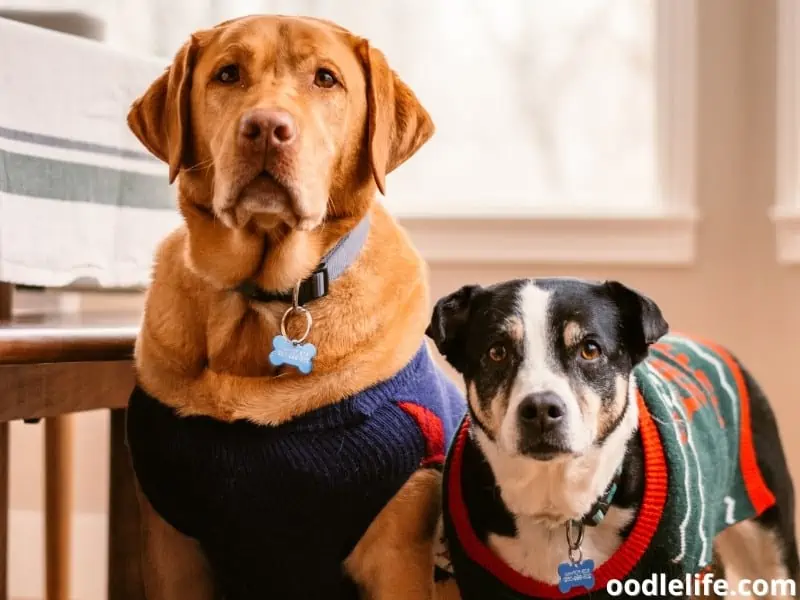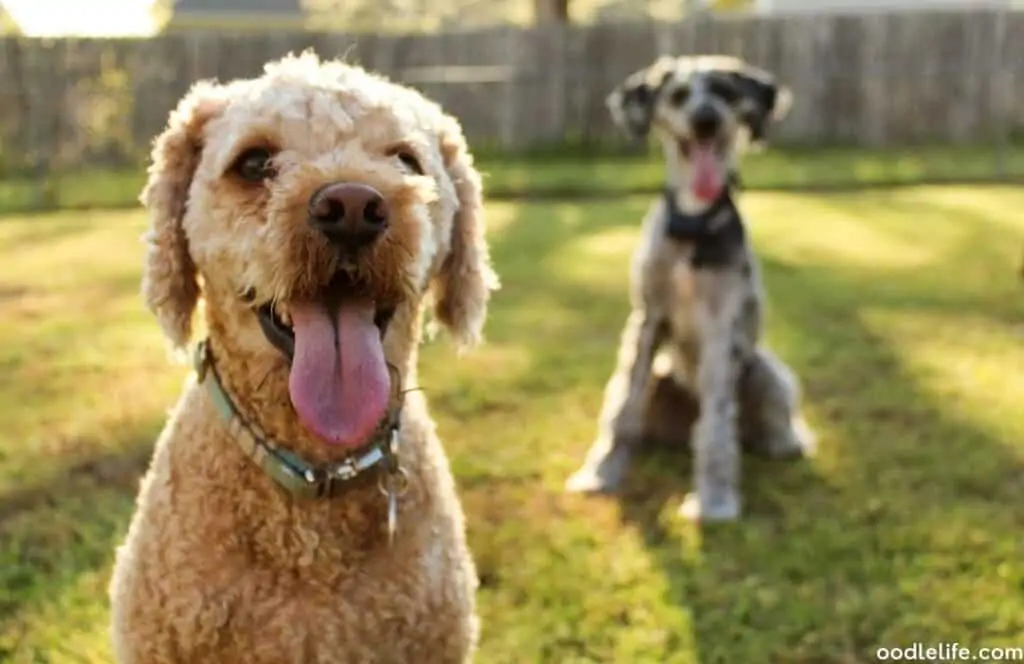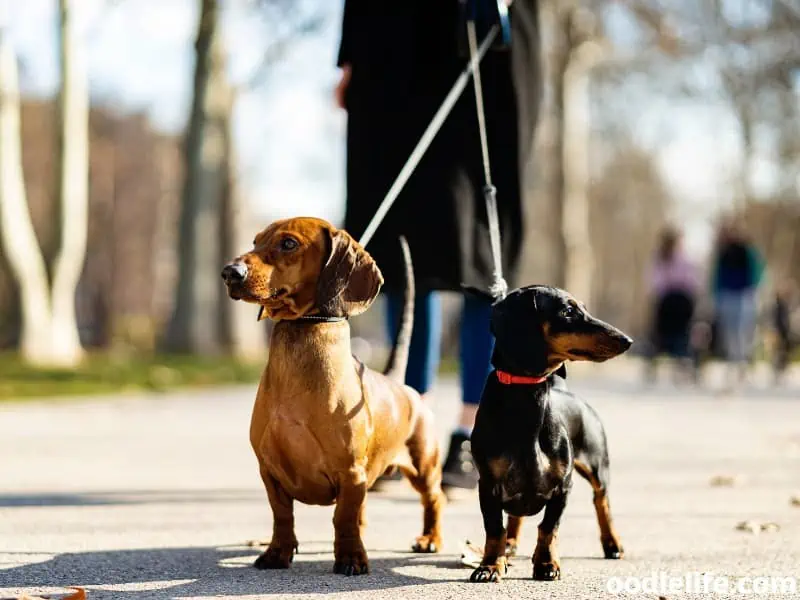How to Introduce a Puppy to a Dominant Dog? [Difficult]
Introducing a new puppy to your household can be an exciting time, but it can also be a challenging one, especially if you already have a dominant dog at home. The process of integrating a young, energetic pup into the mix requires patience, understanding, and a well-planned approach to ensure a seamless and stress-free transition for both dogs.
When it comes to matching a compatible puppy with your dominant dog, there are several factors to take into consideration, such as size and temperament. Preparing for the introduction is crucial, as it sets the foundation for a harmonious relationship between the two pets. Investing time in arranging separate food and water bowls, and designating separate sleeping spaces can go a long way in preventing conflicts before they even start.

The initial meeting should take place in a neutral environment, allowing both dogs to interact with a sense of ease without any territorial disputes. Remember, your dominant dog may need some time to adjust to the new addition, and the puppy will be looking to you for guidance on how to properly interact. By remaining patient, watchful, and using positive reinforcement techniques, you’ll soon have both dogs living happily together, making for countless amusing stories and heartwarming moments in your home.
Understanding Dominant and Submissive Dogs
When it comes to dogs, understanding their personalities is the key to establishing a harmonious relationship. This holds even more importance when introducing a puppy to a dominant dog. Think of it like an office: You have your boss (the alpha dog), the workers (submissive dogs), and now, an intern (the new puppy).

Dominant dogs are often assertive, can get territorial, and like to take charge when it comes to decision-making within the pack. They might show dominance by displaying stiff body language, raising their heads high, or growling when they feel challenged.
On the other hand, submissive dogs are more passive, often displaying appeasement gestures, like lowering their bodies, lifting a paw, or licking the dominant dog’s face. They’re like the sidekick who’s just happy to be along for the ride.
However, all dogs have their individual personalities, and there isn’t a one-size-fits-all approach when dealing with the alpha dog. Just like humans, dogs’ personalities may change with age or circumstances. That “bossy” dog might become a softie when pampered, while the submissive dog could grow into a confident canine over time.
When introducing a puppy to a dominant dog, it’s essential to:
- Observe your dominant dog’s behavior and responses to the puppy.
- Keep the environment neutral and controlled.
- Allow your dogs to interact indirectly first, by keeping them in separate areas of your home.
- Gauge the dominant dog’s comfort and eventually make direct introductions.
Snack time example: Imagine the dominant dog as a kid who always gets the best snacks; when a new sibling comes into the picture, there’s potential sibling rivalry over cookies! So keep separate feeding areas to avoid creating tensions when introducing your puppy.
Remember, understanding your dominant dog’s personality is like unlocking the door to a harmonious doggy relationship. Just like with your friends, coworkers, or even family, it’s crucial to know when to give them space and when to nudge them towards bonding – happy tail wags all around!
Preparing for the First Meeting
Before introducing your new puppy to your adult dog, it’s essential to prepare ahead of time to ensure a smooth and positive interaction. A successful first meeting sets the foundation for a strong bond between your dogs, so let’s dive into a few key steps.

First, find a neutral territory for the initial introduction. This could be a park, a friend’s backyard, or any outdoor area that neither dog has “claimed” through frequent visits. Neutral ground reduces the chances of territorial behavior and helps keep stress and anxiety levels low for both the puppy and the adult dog.
Consider enlisting the help of a friend or family member to handle one of the dogs during the meeting. This allows you to focus on monitoring their behavior and stepping in if needed, without juggling two leashes.
When selecting the perfect neutral spot, ensure it’s securely fenced to keep your furry friends safe. For a touch of canine diplomacy, it’s also a good idea to:
- Carry treats for both dogs as a positive reinforcement
- Provide water, especially on warm days
- Avoid loud, crowded areas that could overwhelm the dogs
Now, let’s briefly discuss these pre-meeting essentials:
- Make sure both dogs are up-to-date on vaccines.
- Have separate food/water bowls, beds, and toys ready at home.
- Create a safe space for the new puppy, where they can retreat without your adult dog bothering them.
- If possible, walk both dogs separately before the meeting to release pent-up energy.
Remember, puppies are like toddlers with paws, while adult dogs have more refined social etiquette. So, expect the unexpected during the meeting, and remain patient. It’s crucial to maintain a confident and positive vibe throughout – your furkids can pick up on your emotions.
Lastly, don’t forget to pack your sense of humor along with the treats. As the saying goes, “Dogs will be dogs,” and sometimes their antics can take a comical turn. Enjoy the process as your four-legged family members lay the foundation for a lifetime of companionship.
Introducing a Puppy to a Dominant Dog

Taking Things Slowly
Introducing a puppy to a dominant dog can be a bit like an awkward first date – nerves and uncertainty all around! To make it easier for both parties, start slowly by introducing them in a neutral area, such as a park or a friend’s backyard. This prevents territorial behavior from the older dog and helps create a more relaxed atmosphere for their first encounter.
During this initial meeting, keep the puppy on a leash to ensure more control over the interaction. The older dog should also be leashed. Be patient, and let the dogs sniff each other out—after all, it’s their way of saying “hello!” Just remember, Rome wasn’t built in a day, so don’t expect instant BFFs after one meeting.
Creating Positive Associations
Like pairing fine wine with an exquisite meal, introducing a puppy to a dominant dog requires creating positive associations during their interactions. Give both dogs treats or praises simultaneously to encourage bonding through positive reinforcement. Think of it as a double high-five for your canine participants.
Additionally, schedule shared activities like walks, playtimes, and even feeding time (while maintaining a safe distance between their bowls). This creates positive associations with each other’s presence, kind of like teamwork among furry companions.
Managing Body Language
Dogs communicate through body language, and we, mere humans, need to be knowledgeable facilitators of their interaction. Keep an eye on both the puppy and the older dog’s body language during their encounters.
Calm body language includes:
- Relaxed posture
- Softly wagging tail
- Open mouth and relaxed ears
Signs of aggression or stress include:
- Raised hackles
- Stiff posture
- Tucked tail
If you notice any aggressive or stressed body language, calmly redirect their attention and give them some space to cool down – think of it as a “doggy time-out.”
Humans also play a role in this situation, as our canine friends can pick up on our emotions. Channel your inner Zen master and remain calm throughout the process, as your attitude will have a ripple effect on both dogs.
In conclusion, when introducing a puppy to a dominant dog, remember that patience, positive reinforcement, and managing body language are key components to creating a harmonious relationship between your furry family members. And hey, if all goes well, they might just become the next dynamic doggy duo!
Setting Rules and Structure
Introducing a puppy to a dominant dog requires clear rules and structure. This helps establish boundaries, reinforces positive behaviors, and maintains a sense of order within your furry family. Ready to become a pup-parenting pro?

Let’s dive in!
Start by setting physical boundaries for both dogs. Crate training can be a wonderful tool to give both the puppy and the dominant dog their own designated space. This helps prevent feelings of territorial invasion and provides a safe retreat when they want some alone time.
So, when you catch your dominant dog binge-watching “The Dogfather,” just remember it’s their “me” time.
Ground rules are vital during socialization as well. Develop separate meal areas to avoid a sudden “spaghetti showdown.” Providing separate food and water bowls prevents resource guarding and helps maintain the pack hierarchy.
No one likes a hungry hip-pupper!
Speaking of pack hierarchy, remember – you’re the Alpha! Make sure to reinforce commands and reward good behaviors consistently. Both dogs should understand that complying with your instructions is the key to belly rubs and endless treats.
When it comes to territorial behaviors, neutral spaces are game-changers. Introduce the new puppy to your dominant pup in an unfamiliar environment, like a park or your great-uncle’s house (crazy dog-art collection, anyone?). This way, neither dog feels the need to defend their turf, allowing them to share stories about chasing squirrels while sipping puppuccinos together.
In summary, clear rules and structure pave the way for a harmonious relationship between your puppy and dominant dog. With boundaries set and a little TLC, your fur babies will soon become the pawfect pack members!
Managing Resources and Attention
Resource guarding is a common issue among dominant dogs. To prevent this from becoming a problem, let’s focus on a few essential strategies to ensure a harmonious introduction between your puppy and the dominant dog.

1. Separation of resources
Start by providing each dog with their own individual space, food bowls, water bowls, toys, and beds. This will help reduce potential tension and conflict between the two.
Example: Use a baby gate to separate their spaces in the initial introduction period, allowing each dog to have their personal space and resources.
2. Equal attention
During the introduction period, give both dogs equal attention to avoid any feelings of jealousy or competition for your affection. Offer them verbal rewards and affection when they exhibit positive behavior, such as calmly tolerating each other’s presence.
Example: Instead of petting one dog while playing with another, try engaging them in a mutual activity like a parallel walk, where each dog is on their leash, and you walk with them side by side.
3. Positivity and reinforcement
Avoid using physical punishment if one dog becomes aggressive or overly dominant. Instead, rely on redirection, verbal cues, and positive reinforcement to resolve tense situations. Be sure to praise your dogs for their good behavior and progress in getting along with each other.
Example: If you notice your dominant dog starting to growl when the puppy approaches its food bowl, calmly redirect the puppy’s attention to its own food bowl and praise them for eating from it.
4. Balance affection
Both dogs need to feel loved. Show them affection in different ways, like cuddling or playing with them one at a time in separate areas. This will give your dominant dog a chance to warm up to the new puppy and slowly build their relationship.
Example: Plan your cuddle sessions with each dog separately. Use a baby gate or separate rooms to create a secure space for each pup to receive affection without feeling threatened or jealous.
Remember that patience and persistence are your best friends in this process. Juggling a new puppy and a dominant dog can be challenging, but with a bit of humor and a keen eye on managing resources and attention, you’ll create a balanced, loving environment for both your furry friends.
Training and Reinforcement Techniques
Training and reinforcement techniques are essential when introducing a puppy to a dominant dog. Keep in mind, managing the situation becomes much smoother when you focus on positive reinforcement.

To begin, ensure that both dogs are on leashes and in a neutral space, like a park or friend’s backyard. This approach helps prevent territorial behaviors from the dominant dog. When the initial meeting takes place, observe their interactions and step in when necessary to correct any aggressive tendencies.
Consider employing the “Nothing In Life Is Free” (NILIF) training philosophy. With this approach, both dogs must perform a basic command, such as “sit” or “stay,” before receiving a reward like food, toys, or affection. This method establishes you as the leader while reinforcing good behavior in both dogs.
A few positive reinforcement techniques include:
- Praise and treats when they display appropriate behaviors
- Stroking and petting both dogs calmly
- Teaching basic commands to the puppy and reinforcing them in the presence of the dominant dog
It might be tempting to lean heavily on the puppy’s training, but don’t forget the dominant dog’s training needs. Remember to keep things balanced while reinforcing their established routines and commands – this way, the dominant dog doesn’t feel like they’re losing their well-earned position in the household.
In the early stages of their introduction, keep playtime light and well-monitored. If the dominant dog becomes too aggressive during play, redirect them by offering a toy or initiating an obedience training session. When done correctly, redirection helps channel their energy into more appropriate outlets.
Here’s an analogy to keep in mind: training a puppy and a dominant dog is like teaching two dance partners the steps of a waltz. It takes time, patience, and a keen understanding of their roles in the dance. But once they’ve grasped the rhythm, they’ll make a graceful pair that elegantly moves in sync.
In a nutshell, focus on positive reinforcement, training for both the puppy and dominant dog, and maintaining a consistent, confident, and clear approach in your interactions. With time and patience, you’ll likely see your dogs’ relationship evolve into a harmonious one. And possibly, you might even hear them howl a canine duet or two together.
Supervised Playtime and Exercise
Introducing a new puppy to a dominant older dog can be a bit challenging, somewhat like an awkward in-law meeting. But fear not! Utilizing supervised playtime and exercise can help smooth things over and make it a success.

First off, it’s essential to find a neutral setting for the initial meeting, such as a park, so that neither dog feels like their territory is being invaded. Think of it as a canine coffee shop date.
When you first introduce the two dogs, keep them on leashes and let them have a sniff at each other. Their body language will say a lot about how they feel about each other. If their tails are wagging and they look relaxed, that’s a great sign.
On the other hand, if you see growling, stiff tails, and pulled-back ears, it’s time for a break. They might need some “paws” to cool off before trying again.
During supervised playtime, make sure to keep a watchful eye on their interactions. A bit of roughhousing is okay, but if you notice any signs of aggression, intervene before things escalate. Don’t forget to provide each of them with their toys to prevent any toy tug-of-war – no one likes sharing with someone they barely know.
Incorporate exercise into their routine by taking the dogs on walks together. This helps them understand that they are both part of the same pack. If they are not quite ready to walk side by side, you can start by having one person walk each dog at a distance, gradually closing the gap with time.
Remember, Rome wasn’t built in a day, and neither are doggy friendships.
Lastly, don’t forget to praise and reward both dogs when they exhibit good behavior during playtime and exercise. After all, everyone loves being acknowledged for getting along with others – just like getting a gold star in school.
As you can see, supervised playtime and exercise are crucial in fostering a harmonious relationship between a new puppy and a dominant dog. With patience and perseverance, they’ll soon become best buddies, or at least tolerable roommates.
Monitoring Progress and Addressing Concerns
As a dog owner, it’s essential to be patient and vigilant while your puppy and dominant dog adjust to each other. This process might require some time, as they get to know and respect one another. Remember, Rome wasn’t built in a day, and neither will your dogs’ relationship!

Keep an eye on their interactions, and assess their progress regularly. Look for signs of fear or aggression in both dogs. If you notice one dog becoming overly stressed, it’s time to intervene and create some space for a “mental health break.”
It’s crucial to establish “safe zones” where each dog can retreat and relax without the other’s presence. For example, you could use separate rooms, crates, or designated rest areas. These areas shouldn’t be in each other’s line of sight, as uninterrupted eye contact can create tension between canines.
To avoid a situation like staring contests that quickly escalate to WWE-style doggy wrestling matches, organizers of the national canine staring championships advise dog owners to keep eyesight separated.
If troubling behaviors persist, it’s time to consult a professional dog behaviorist. They can assess the situation and offer personalized guidance tailored to your furry family members. A behaviorist is like an interpreter between your dogs’ body language and human understanding – the Cesar Millan of doggo communication!
Don’t be discouraged; sometimes, humans need help deciphering the secret language of woofs, growls, and tail wags.
In conclusion, patience and time are the key ingredients while monitoring the progress of your dogs’ relationship. Wait no, I said no conclusion! Scratch that last sentence.
Remember your role as a dog owner, and trust that with dedication and a watchful eye, your pup and dominant dog will learn to coexist harmoniously.